Report: Working Capital, Capital Budgeting, and Financial Analysis
VerifiedAdded on 2019/12/17
|11
|3700
|182
Report
AI Summary
This report delves into crucial aspects of business finance, focusing on working capital management and capital budgeting. It begins by differentiating between profitability and cash flows, emphasizing their importance for business operations, and analyzes a case study of Wild Frontiers Builders Ltd, which faces liquidity crises despite profitability. The report suggests measures to improve working capital management, such as cash flow forecasting, dispute resolution, and just-in-time inventory. The second part of the report addresses capital budgeting, outlining the stages involved and the main investment appraisal methods, including Net Present Value (NPV) and Accounting Rate of Return (ARR). The report then applies these methods to potential projects, like Eye Watering Inc., and analyzes their applicability, offering a comprehensive overview of financial decision-making in business.
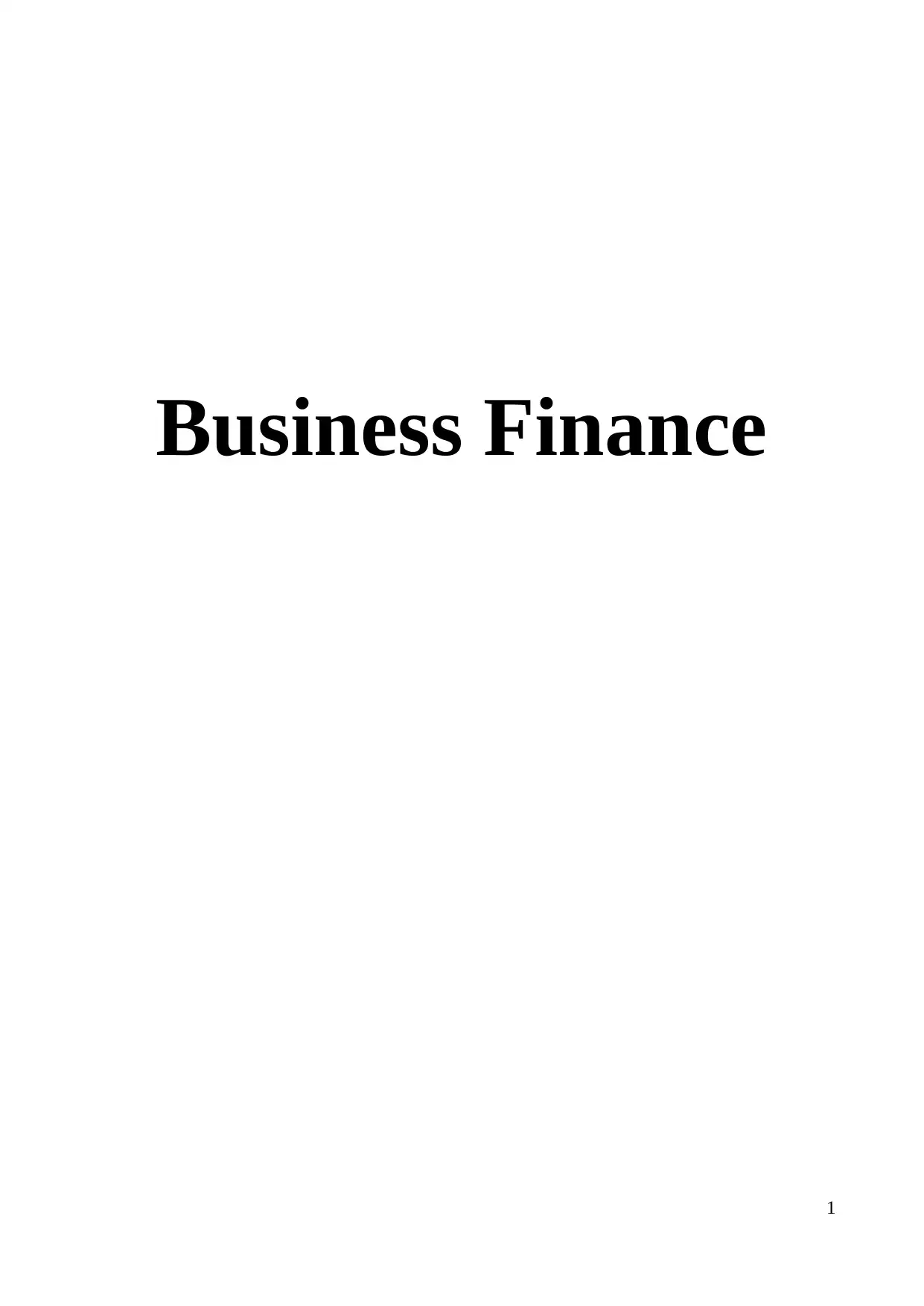
Business Finance
1
1
Paraphrase This Document
Need a fresh take? Get an instant paraphrase of this document with our AI Paraphraser
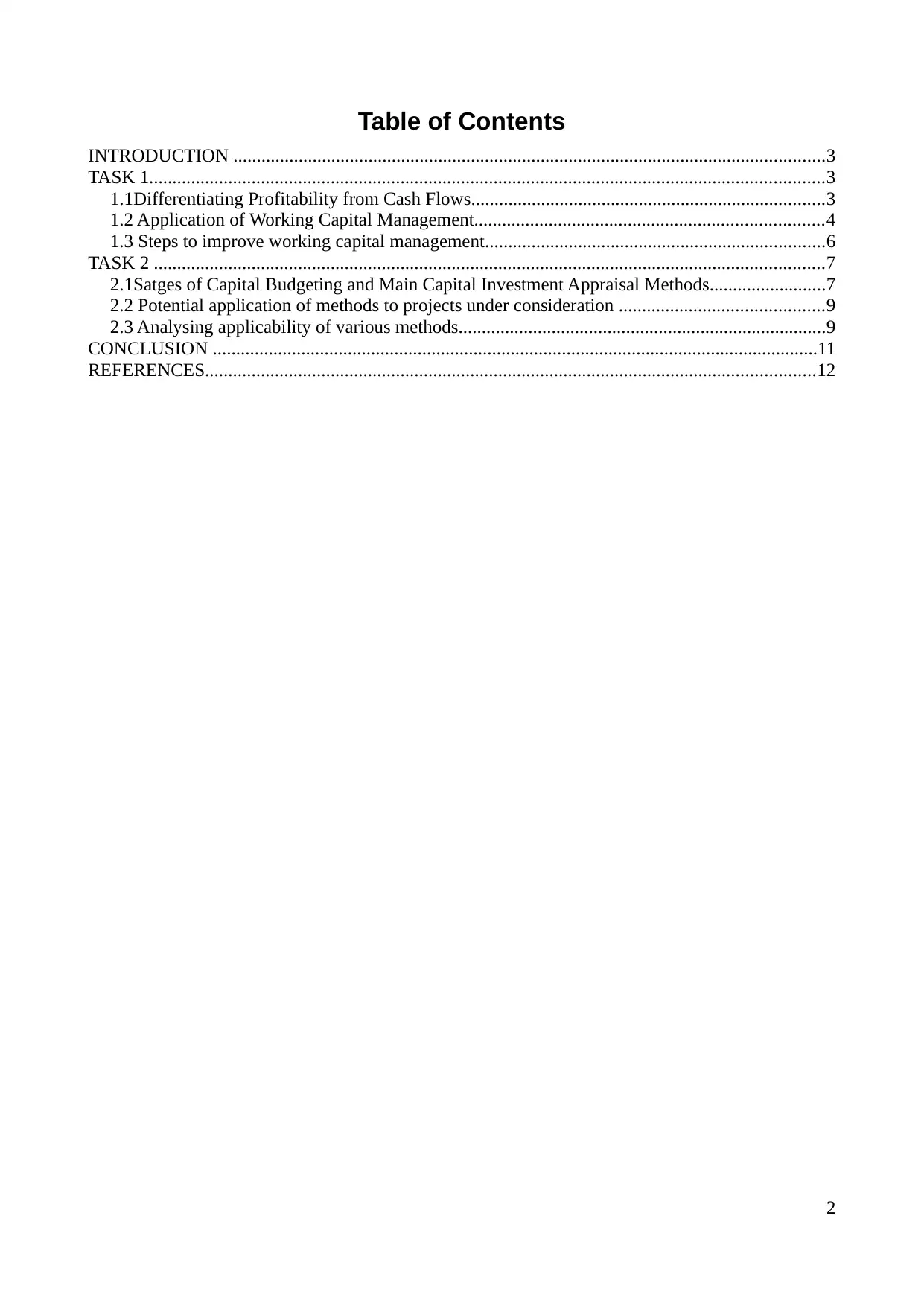
Table of Contents
INTRODUCTION ...............................................................................................................................3
TASK 1.................................................................................................................................................3
1.1Differentiating Profitability from Cash Flows............................................................................3
1.2 Application of Working Capital Management...........................................................................4
1.3 Steps to improve working capital management.........................................................................6
TASK 2 ................................................................................................................................................7
2.1Satges of Capital Budgeting and Main Capital Investment Appraisal Methods.........................7
2.2 Potential application of methods to projects under consideration ............................................9
2.3 Analysing applicability of various methods...............................................................................9
CONCLUSION ..................................................................................................................................11
REFERENCES...................................................................................................................................12
2
INTRODUCTION ...............................................................................................................................3
TASK 1.................................................................................................................................................3
1.1Differentiating Profitability from Cash Flows............................................................................3
1.2 Application of Working Capital Management...........................................................................4
1.3 Steps to improve working capital management.........................................................................6
TASK 2 ................................................................................................................................................7
2.1Satges of Capital Budgeting and Main Capital Investment Appraisal Methods.........................7
2.2 Potential application of methods to projects under consideration ............................................9
2.3 Analysing applicability of various methods...............................................................................9
CONCLUSION ..................................................................................................................................11
REFERENCES...................................................................................................................................12
2
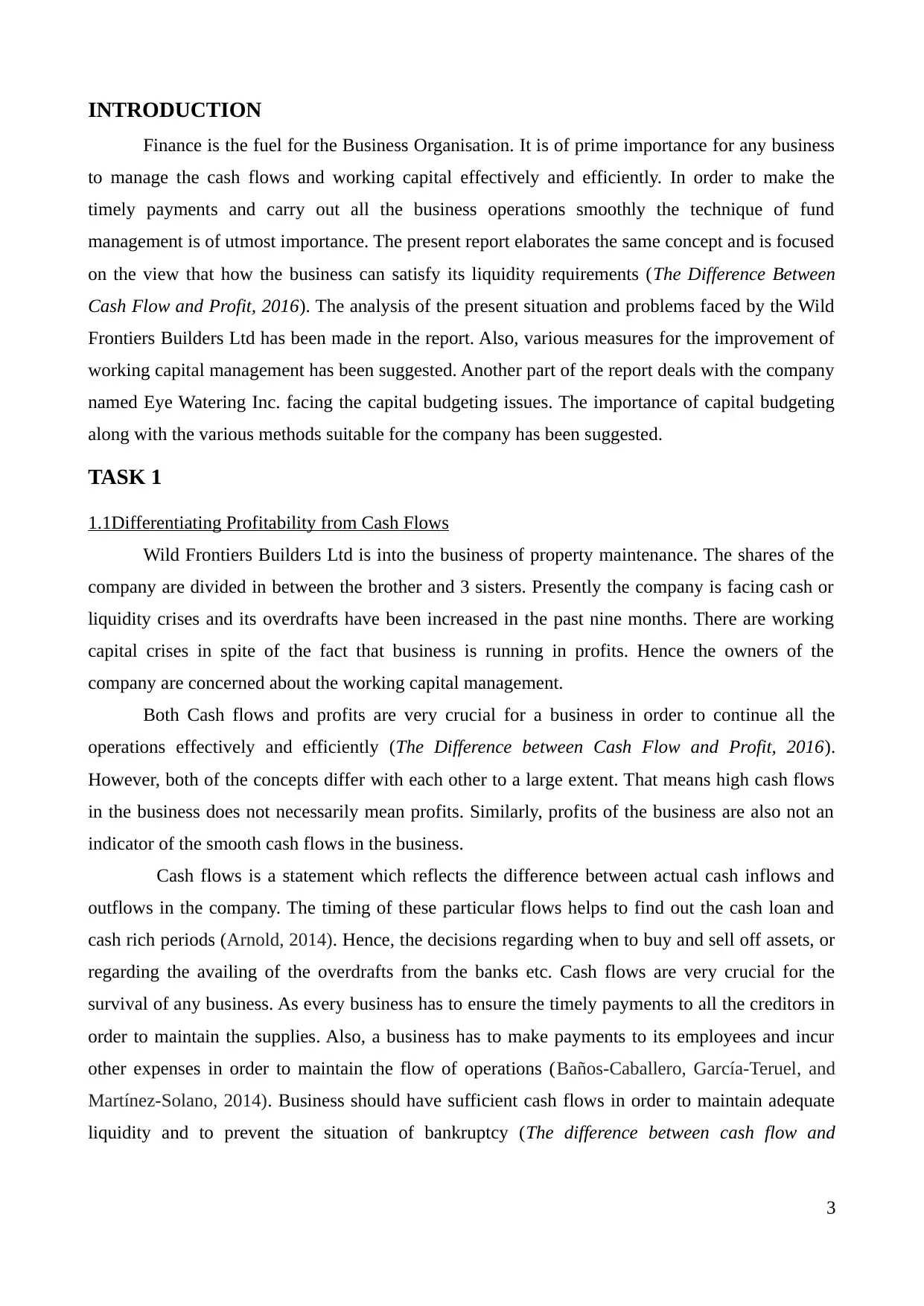
INTRODUCTION
Finance is the fuel for the Business Organisation. It is of prime importance for any business
to manage the cash flows and working capital effectively and efficiently. In order to make the
timely payments and carry out all the business operations smoothly the technique of fund
management is of utmost importance. The present report elaborates the same concept and is focused
on the view that how the business can satisfy its liquidity requirements (The Difference Between
Cash Flow and Profit, 2016). The analysis of the present situation and problems faced by the Wild
Frontiers Builders Ltd has been made in the report. Also, various measures for the improvement of
working capital management has been suggested. Another part of the report deals with the company
named Eye Watering Inc. facing the capital budgeting issues. The importance of capital budgeting
along with the various methods suitable for the company has been suggested.
TASK 1
1.1Differentiating Profitability from Cash Flows
Wild Frontiers Builders Ltd is into the business of property maintenance. The shares of the
company are divided in between the brother and 3 sisters. Presently the company is facing cash or
liquidity crises and its overdrafts have been increased in the past nine months. There are working
capital crises in spite of the fact that business is running in profits. Hence the owners of the
company are concerned about the working capital management.
Both Cash flows and profits are very crucial for a business in order to continue all the
operations effectively and efficiently (The Difference between Cash Flow and Profit, 2016).
However, both of the concepts differ with each other to a large extent. That means high cash flows
in the business does not necessarily mean profits. Similarly, profits of the business are also not an
indicator of the smooth cash flows in the business.
Cash flows is a statement which reflects the difference between actual cash inflows and
outflows in the company. The timing of these particular flows helps to find out the cash loan and
cash rich periods (Arnold, 2014). Hence, the decisions regarding when to buy and sell off assets, or
regarding the availing of the overdrafts from the banks etc. Cash flows are very crucial for the
survival of any business. As every business has to ensure the timely payments to all the creditors in
order to maintain the supplies. Also, a business has to make payments to its employees and incur
other expenses in order to maintain the flow of operations (Baños-Caballero, García-Teruel, and
Martínez-Solano, 2014). Business should have sufficient cash flows in order to maintain adequate
liquidity and to prevent the situation of bankruptcy (The difference between cash flow and
3
Finance is the fuel for the Business Organisation. It is of prime importance for any business
to manage the cash flows and working capital effectively and efficiently. In order to make the
timely payments and carry out all the business operations smoothly the technique of fund
management is of utmost importance. The present report elaborates the same concept and is focused
on the view that how the business can satisfy its liquidity requirements (The Difference Between
Cash Flow and Profit, 2016). The analysis of the present situation and problems faced by the Wild
Frontiers Builders Ltd has been made in the report. Also, various measures for the improvement of
working capital management has been suggested. Another part of the report deals with the company
named Eye Watering Inc. facing the capital budgeting issues. The importance of capital budgeting
along with the various methods suitable for the company has been suggested.
TASK 1
1.1Differentiating Profitability from Cash Flows
Wild Frontiers Builders Ltd is into the business of property maintenance. The shares of the
company are divided in between the brother and 3 sisters. Presently the company is facing cash or
liquidity crises and its overdrafts have been increased in the past nine months. There are working
capital crises in spite of the fact that business is running in profits. Hence the owners of the
company are concerned about the working capital management.
Both Cash flows and profits are very crucial for a business in order to continue all the
operations effectively and efficiently (The Difference between Cash Flow and Profit, 2016).
However, both of the concepts differ with each other to a large extent. That means high cash flows
in the business does not necessarily mean profits. Similarly, profits of the business are also not an
indicator of the smooth cash flows in the business.
Cash flows is a statement which reflects the difference between actual cash inflows and
outflows in the company. The timing of these particular flows helps to find out the cash loan and
cash rich periods (Arnold, 2014). Hence, the decisions regarding when to buy and sell off assets, or
regarding the availing of the overdrafts from the banks etc. Cash flows are very crucial for the
survival of any business. As every business has to ensure the timely payments to all the creditors in
order to maintain the supplies. Also, a business has to make payments to its employees and incur
other expenses in order to maintain the flow of operations (Baños-Caballero, García-Teruel, and
Martínez-Solano, 2014). Business should have sufficient cash flows in order to maintain adequate
liquidity and to prevent the situation of bankruptcy (The difference between cash flow and
3
⊘ This is a preview!⊘
Do you want full access?
Subscribe today to unlock all pages.

Trusted by 1+ million students worldwide
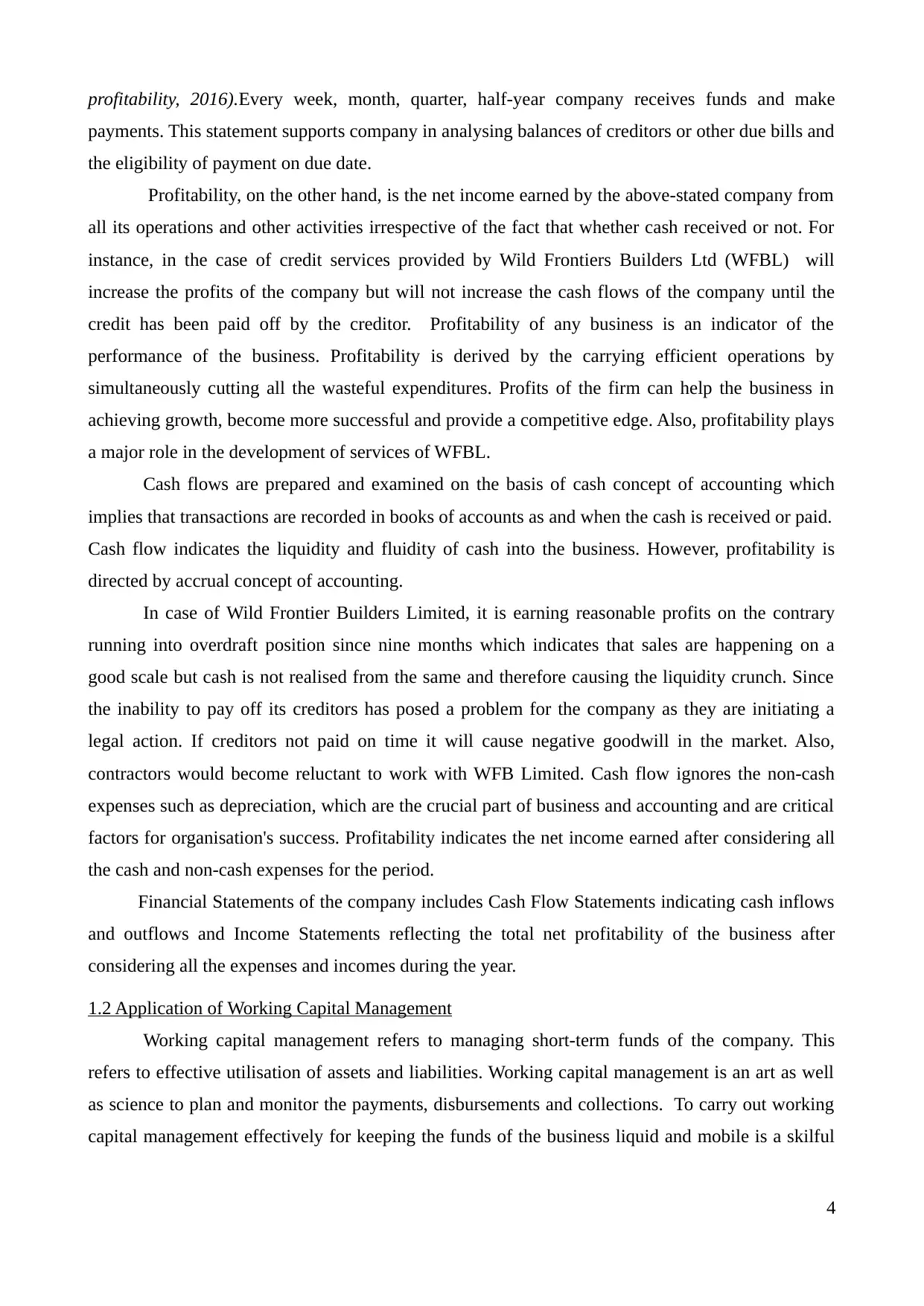
profitability, 2016).Every week, month, quarter, half-year company receives funds and make
payments. This statement supports company in analysing balances of creditors or other due bills and
the eligibility of payment on due date.
Profitability, on the other hand, is the net income earned by the above-stated company from
all its operations and other activities irrespective of the fact that whether cash received or not. For
instance, in the case of credit services provided by Wild Frontiers Builders Ltd (WFBL) will
increase the profits of the company but will not increase the cash flows of the company until the
credit has been paid off by the creditor. Profitability of any business is an indicator of the
performance of the business. Profitability is derived by the carrying efficient operations by
simultaneously cutting all the wasteful expenditures. Profits of the firm can help the business in
achieving growth, become more successful and provide a competitive edge. Also, profitability plays
a major role in the development of services of WFBL.
Cash flows are prepared and examined on the basis of cash concept of accounting which
implies that transactions are recorded in books of accounts as and when the cash is received or paid.
Cash flow indicates the liquidity and fluidity of cash into the business. However, profitability is
directed by accrual concept of accounting.
In case of Wild Frontier Builders Limited, it is earning reasonable profits on the contrary
running into overdraft position since nine months which indicates that sales are happening on a
good scale but cash is not realised from the same and therefore causing the liquidity crunch. Since
the inability to pay off its creditors has posed a problem for the company as they are initiating a
legal action. If creditors not paid on time it will cause negative goodwill in the market. Also,
contractors would become reluctant to work with WFB Limited. Cash flow ignores the non-cash
expenses such as depreciation, which are the crucial part of business and accounting and are critical
factors for organisation's success. Profitability indicates the net income earned after considering all
the cash and non-cash expenses for the period.
Financial Statements of the company includes Cash Flow Statements indicating cash inflows
and outflows and Income Statements reflecting the total net profitability of the business after
considering all the expenses and incomes during the year.
1.2 Application of Working Capital Management
Working capital management refers to managing short-term funds of the company. This
refers to effective utilisation of assets and liabilities. Working capital management is an art as well
as science to plan and monitor the payments, disbursements and collections. To carry out working
capital management effectively for keeping the funds of the business liquid and mobile is a skilful
4
payments. This statement supports company in analysing balances of creditors or other due bills and
the eligibility of payment on due date.
Profitability, on the other hand, is the net income earned by the above-stated company from
all its operations and other activities irrespective of the fact that whether cash received or not. For
instance, in the case of credit services provided by Wild Frontiers Builders Ltd (WFBL) will
increase the profits of the company but will not increase the cash flows of the company until the
credit has been paid off by the creditor. Profitability of any business is an indicator of the
performance of the business. Profitability is derived by the carrying efficient operations by
simultaneously cutting all the wasteful expenditures. Profits of the firm can help the business in
achieving growth, become more successful and provide a competitive edge. Also, profitability plays
a major role in the development of services of WFBL.
Cash flows are prepared and examined on the basis of cash concept of accounting which
implies that transactions are recorded in books of accounts as and when the cash is received or paid.
Cash flow indicates the liquidity and fluidity of cash into the business. However, profitability is
directed by accrual concept of accounting.
In case of Wild Frontier Builders Limited, it is earning reasonable profits on the contrary
running into overdraft position since nine months which indicates that sales are happening on a
good scale but cash is not realised from the same and therefore causing the liquidity crunch. Since
the inability to pay off its creditors has posed a problem for the company as they are initiating a
legal action. If creditors not paid on time it will cause negative goodwill in the market. Also,
contractors would become reluctant to work with WFB Limited. Cash flow ignores the non-cash
expenses such as depreciation, which are the crucial part of business and accounting and are critical
factors for organisation's success. Profitability indicates the net income earned after considering all
the cash and non-cash expenses for the period.
Financial Statements of the company includes Cash Flow Statements indicating cash inflows
and outflows and Income Statements reflecting the total net profitability of the business after
considering all the expenses and incomes during the year.
1.2 Application of Working Capital Management
Working capital management refers to managing short-term funds of the company. This
refers to effective utilisation of assets and liabilities. Working capital management is an art as well
as science to plan and monitor the payments, disbursements and collections. To carry out working
capital management effectively for keeping the funds of the business liquid and mobile is a skilful
4
Paraphrase This Document
Need a fresh take? Get an instant paraphrase of this document with our AI Paraphraser
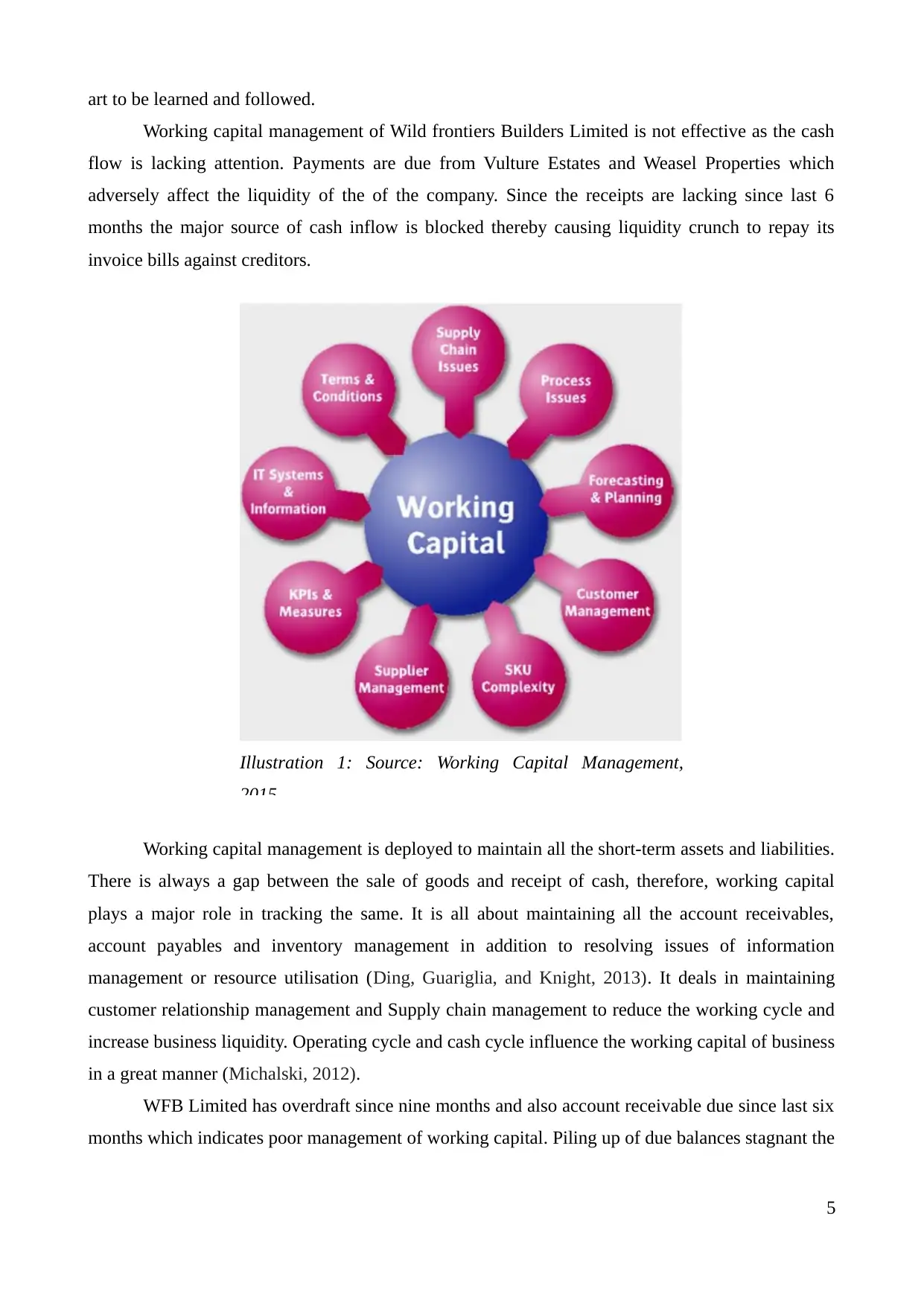
art to be learned and followed.
Working capital management of Wild frontiers Builders Limited is not effective as the cash
flow is lacking attention. Payments are due from Vulture Estates and Weasel Properties which
adversely affect the liquidity of the of the company. Since the receipts are lacking since last 6
months the major source of cash inflow is blocked thereby causing liquidity crunch to repay its
invoice bills against creditors.
Working capital management is deployed to maintain all the short-term assets and liabilities.
There is always a gap between the sale of goods and receipt of cash, therefore, working capital
plays a major role in tracking the same. It is all about maintaining all the account receivables,
account payables and inventory management in addition to resolving issues of information
management or resource utilisation (Ding, Guariglia, and Knight, 2013). It deals in maintaining
customer relationship management and Supply chain management to reduce the working cycle and
increase business liquidity. Operating cycle and cash cycle influence the working capital of business
in a great manner (Michalski, 2012).
WFB Limited has overdraft since nine months and also account receivable due since last six
months which indicates poor management of working capital. Piling up of due balances stagnant the
5
Illustration 1: Source: Working Capital Management,
2015.
Working capital management of Wild frontiers Builders Limited is not effective as the cash
flow is lacking attention. Payments are due from Vulture Estates and Weasel Properties which
adversely affect the liquidity of the of the company. Since the receipts are lacking since last 6
months the major source of cash inflow is blocked thereby causing liquidity crunch to repay its
invoice bills against creditors.
Working capital management is deployed to maintain all the short-term assets and liabilities.
There is always a gap between the sale of goods and receipt of cash, therefore, working capital
plays a major role in tracking the same. It is all about maintaining all the account receivables,
account payables and inventory management in addition to resolving issues of information
management or resource utilisation (Ding, Guariglia, and Knight, 2013). It deals in maintaining
customer relationship management and Supply chain management to reduce the working cycle and
increase business liquidity. Operating cycle and cash cycle influence the working capital of business
in a great manner (Michalski, 2012).
WFB Limited has overdraft since nine months and also account receivable due since last six
months which indicates poor management of working capital. Piling up of due balances stagnant the
5
Illustration 1: Source: Working Capital Management,
2015.
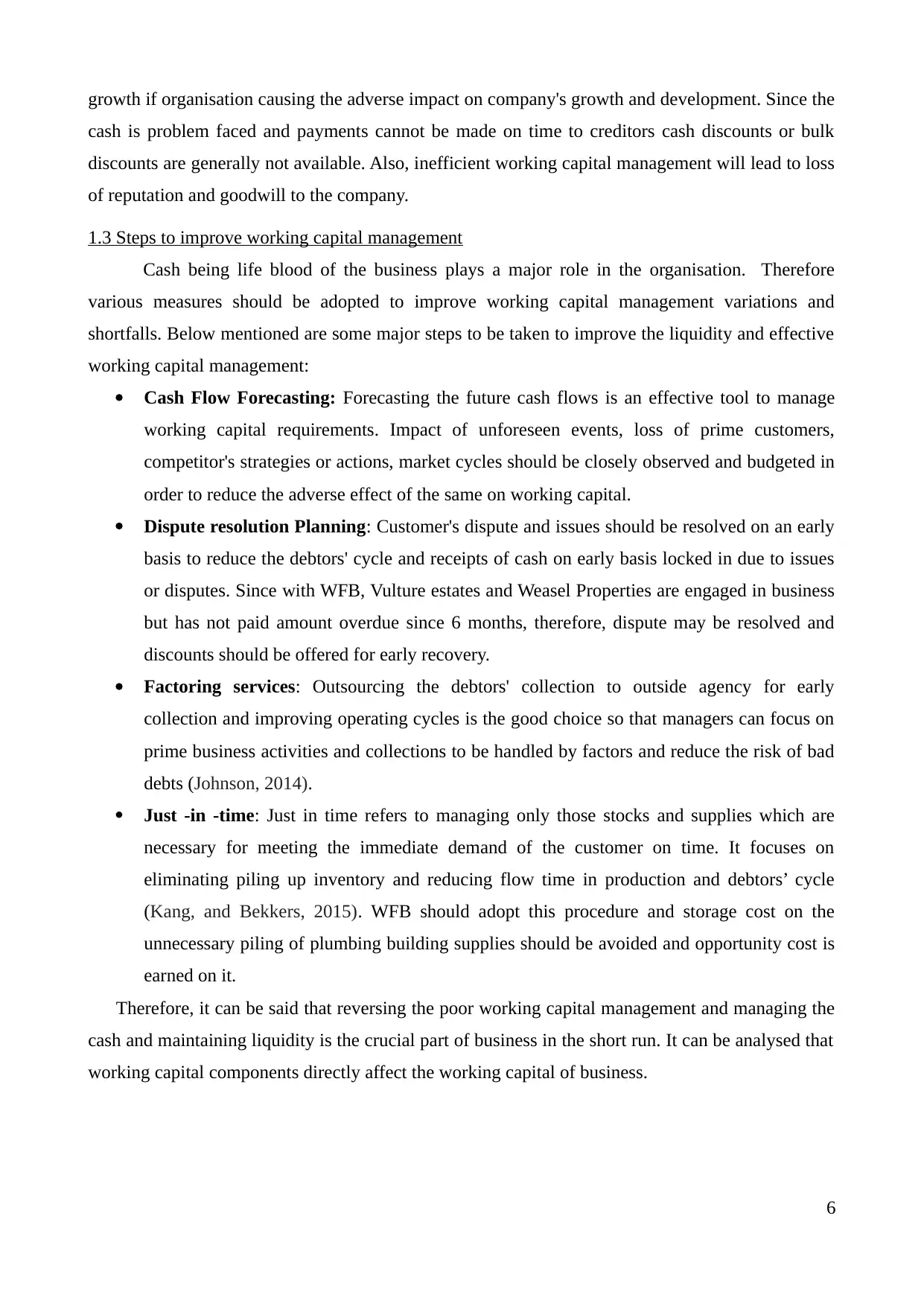
growth if organisation causing the adverse impact on company's growth and development. Since the
cash is problem faced and payments cannot be made on time to creditors cash discounts or bulk
discounts are generally not available. Also, inefficient working capital management will lead to loss
of reputation and goodwill to the company.
1.3 Steps to improve working capital management
Cash being life blood of the business plays a major role in the organisation. Therefore
various measures should be adopted to improve working capital management variations and
shortfalls. Below mentioned are some major steps to be taken to improve the liquidity and effective
working capital management:
Cash Flow Forecasting: Forecasting the future cash flows is an effective tool to manage
working capital requirements. Impact of unforeseen events, loss of prime customers,
competitor's strategies or actions, market cycles should be closely observed and budgeted in
order to reduce the adverse effect of the same on working capital.
Dispute resolution Planning: Customer's dispute and issues should be resolved on an early
basis to reduce the debtors' cycle and receipts of cash on early basis locked in due to issues
or disputes. Since with WFB, Vulture estates and Weasel Properties are engaged in business
but has not paid amount overdue since 6 months, therefore, dispute may be resolved and
discounts should be offered for early recovery.
Factoring services: Outsourcing the debtors' collection to outside agency for early
collection and improving operating cycles is the good choice so that managers can focus on
prime business activities and collections to be handled by factors and reduce the risk of bad
debts (Johnson, 2014).
Just -in -time: Just in time refers to managing only those stocks and supplies which are
necessary for meeting the immediate demand of the customer on time. It focuses on
eliminating piling up inventory and reducing flow time in production and debtors’ cycle
(Kang, and Bekkers, 2015). WFB should adopt this procedure and storage cost on the
unnecessary piling of plumbing building supplies should be avoided and opportunity cost is
earned on it.
Therefore, it can be said that reversing the poor working capital management and managing the
cash and maintaining liquidity is the crucial part of business in the short run. It can be analysed that
working capital components directly affect the working capital of business.
6
cash is problem faced and payments cannot be made on time to creditors cash discounts or bulk
discounts are generally not available. Also, inefficient working capital management will lead to loss
of reputation and goodwill to the company.
1.3 Steps to improve working capital management
Cash being life blood of the business plays a major role in the organisation. Therefore
various measures should be adopted to improve working capital management variations and
shortfalls. Below mentioned are some major steps to be taken to improve the liquidity and effective
working capital management:
Cash Flow Forecasting: Forecasting the future cash flows is an effective tool to manage
working capital requirements. Impact of unforeseen events, loss of prime customers,
competitor's strategies or actions, market cycles should be closely observed and budgeted in
order to reduce the adverse effect of the same on working capital.
Dispute resolution Planning: Customer's dispute and issues should be resolved on an early
basis to reduce the debtors' cycle and receipts of cash on early basis locked in due to issues
or disputes. Since with WFB, Vulture estates and Weasel Properties are engaged in business
but has not paid amount overdue since 6 months, therefore, dispute may be resolved and
discounts should be offered for early recovery.
Factoring services: Outsourcing the debtors' collection to outside agency for early
collection and improving operating cycles is the good choice so that managers can focus on
prime business activities and collections to be handled by factors and reduce the risk of bad
debts (Johnson, 2014).
Just -in -time: Just in time refers to managing only those stocks and supplies which are
necessary for meeting the immediate demand of the customer on time. It focuses on
eliminating piling up inventory and reducing flow time in production and debtors’ cycle
(Kang, and Bekkers, 2015). WFB should adopt this procedure and storage cost on the
unnecessary piling of plumbing building supplies should be avoided and opportunity cost is
earned on it.
Therefore, it can be said that reversing the poor working capital management and managing the
cash and maintaining liquidity is the crucial part of business in the short run. It can be analysed that
working capital components directly affect the working capital of business.
6
⊘ This is a preview!⊘
Do you want full access?
Subscribe today to unlock all pages.

Trusted by 1+ million students worldwide
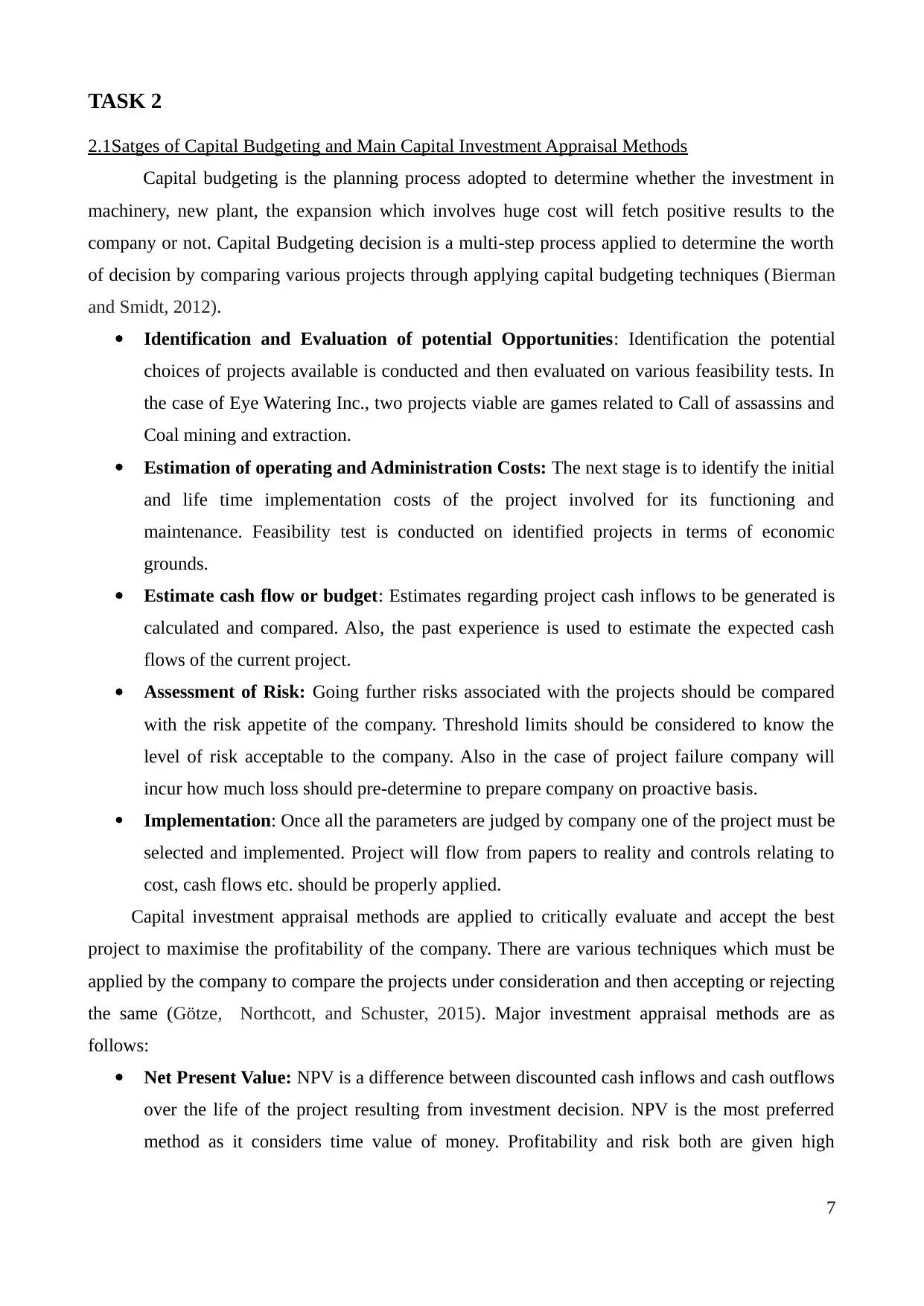
TASK 2
2.1Satges of Capital Budgeting and Main Capital Investment Appraisal Methods
Capital budgeting is the planning process adopted to determine whether the investment in
machinery, new plant, the expansion which involves huge cost will fetch positive results to the
company or not. Capital Budgeting decision is a multi-step process applied to determine the worth
of decision by comparing various projects through applying capital budgeting techniques (Bierman
and Smidt, 2012).
Identification and Evaluation of potential Opportunities: Identification the potential
choices of projects available is conducted and then evaluated on various feasibility tests. In
the case of Eye Watering Inc., two projects viable are games related to Call of assassins and
Coal mining and extraction.
Estimation of operating and Administration Costs: The next stage is to identify the initial
and life time implementation costs of the project involved for its functioning and
maintenance. Feasibility test is conducted on identified projects in terms of economic
grounds.
Estimate cash flow or budget: Estimates regarding project cash inflows to be generated is
calculated and compared. Also, the past experience is used to estimate the expected cash
flows of the current project.
Assessment of Risk: Going further risks associated with the projects should be compared
with the risk appetite of the company. Threshold limits should be considered to know the
level of risk acceptable to the company. Also in the case of project failure company will
incur how much loss should pre-determine to prepare company on proactive basis.
Implementation: Once all the parameters are judged by company one of the project must be
selected and implemented. Project will flow from papers to reality and controls relating to
cost, cash flows etc. should be properly applied.
Capital investment appraisal methods are applied to critically evaluate and accept the best
project to maximise the profitability of the company. There are various techniques which must be
applied by the company to compare the projects under consideration and then accepting or rejecting
the same (Götze, Northcott, and Schuster, 2015). Major investment appraisal methods are as
follows:
Net Present Value: NPV is a difference between discounted cash inflows and cash outflows
over the life of the project resulting from investment decision. NPV is the most preferred
method as it considers time value of money. Profitability and risk both are given high
7
2.1Satges of Capital Budgeting and Main Capital Investment Appraisal Methods
Capital budgeting is the planning process adopted to determine whether the investment in
machinery, new plant, the expansion which involves huge cost will fetch positive results to the
company or not. Capital Budgeting decision is a multi-step process applied to determine the worth
of decision by comparing various projects through applying capital budgeting techniques (Bierman
and Smidt, 2012).
Identification and Evaluation of potential Opportunities: Identification the potential
choices of projects available is conducted and then evaluated on various feasibility tests. In
the case of Eye Watering Inc., two projects viable are games related to Call of assassins and
Coal mining and extraction.
Estimation of operating and Administration Costs: The next stage is to identify the initial
and life time implementation costs of the project involved for its functioning and
maintenance. Feasibility test is conducted on identified projects in terms of economic
grounds.
Estimate cash flow or budget: Estimates regarding project cash inflows to be generated is
calculated and compared. Also, the past experience is used to estimate the expected cash
flows of the current project.
Assessment of Risk: Going further risks associated with the projects should be compared
with the risk appetite of the company. Threshold limits should be considered to know the
level of risk acceptable to the company. Also in the case of project failure company will
incur how much loss should pre-determine to prepare company on proactive basis.
Implementation: Once all the parameters are judged by company one of the project must be
selected and implemented. Project will flow from papers to reality and controls relating to
cost, cash flows etc. should be properly applied.
Capital investment appraisal methods are applied to critically evaluate and accept the best
project to maximise the profitability of the company. There are various techniques which must be
applied by the company to compare the projects under consideration and then accepting or rejecting
the same (Götze, Northcott, and Schuster, 2015). Major investment appraisal methods are as
follows:
Net Present Value: NPV is a difference between discounted cash inflows and cash outflows
over the life of the project resulting from investment decision. NPV is the most preferred
method as it considers time value of money. Profitability and risk both are given high
7
Paraphrase This Document
Need a fresh take? Get an instant paraphrase of this document with our AI Paraphraser
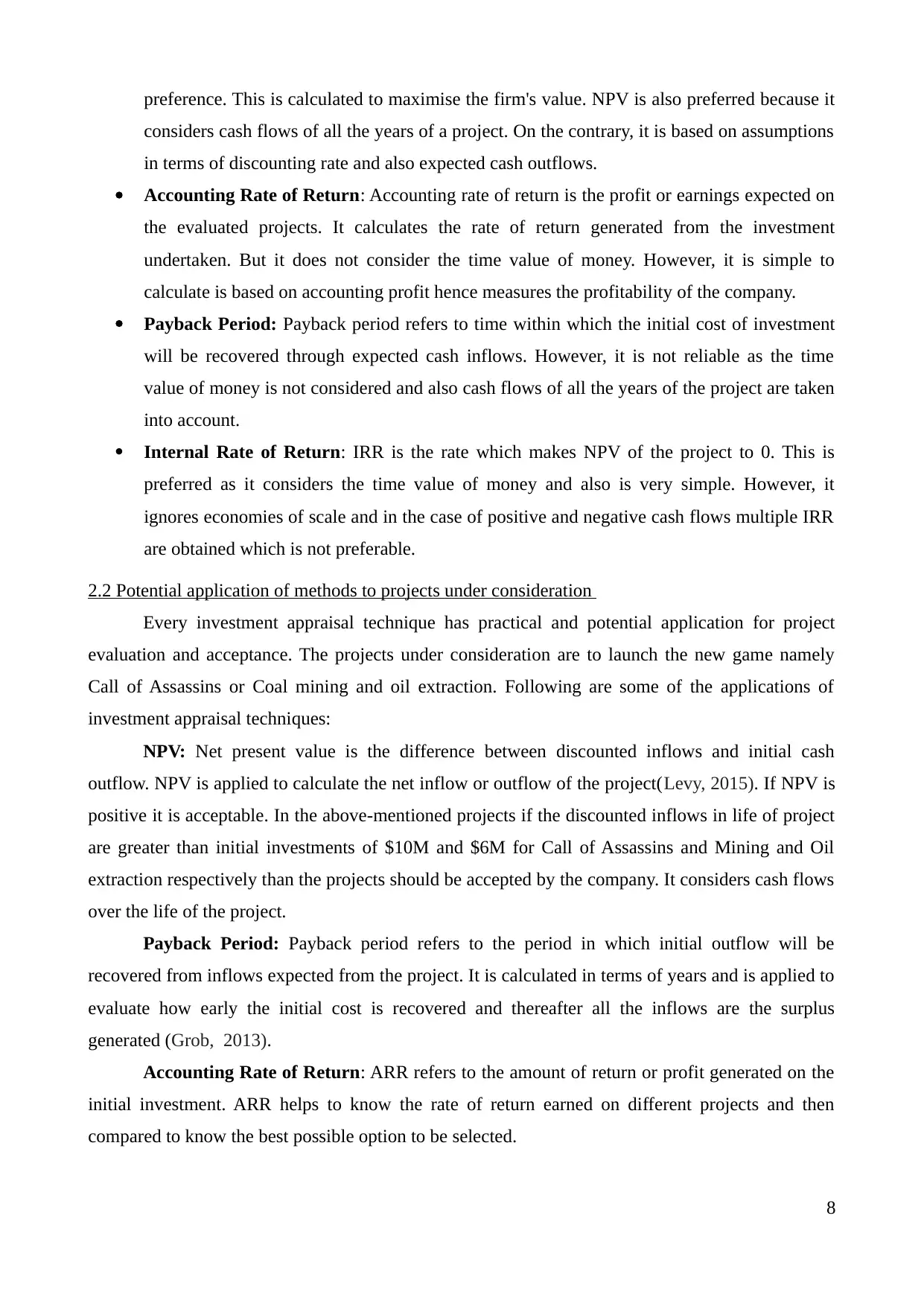
preference. This is calculated to maximise the firm's value. NPV is also preferred because it
considers cash flows of all the years of a project. On the contrary, it is based on assumptions
in terms of discounting rate and also expected cash outflows.
Accounting Rate of Return: Accounting rate of return is the profit or earnings expected on
the evaluated projects. It calculates the rate of return generated from the investment
undertaken. But it does not consider the time value of money. However, it is simple to
calculate is based on accounting profit hence measures the profitability of the company.
Payback Period: Payback period refers to time within which the initial cost of investment
will be recovered through expected cash inflows. However, it is not reliable as the time
value of money is not considered and also cash flows of all the years of the project are taken
into account.
Internal Rate of Return: IRR is the rate which makes NPV of the project to 0. This is
preferred as it considers the time value of money and also is very simple. However, it
ignores economies of scale and in the case of positive and negative cash flows multiple IRR
are obtained which is not preferable.
2.2 Potential application of methods to projects under consideration
Every investment appraisal technique has practical and potential application for project
evaluation and acceptance. The projects under consideration are to launch the new game namely
Call of Assassins or Coal mining and oil extraction. Following are some of the applications of
investment appraisal techniques:
NPV: Net present value is the difference between discounted inflows and initial cash
outflow. NPV is applied to calculate the net inflow or outflow of the project(Levy, 2015). If NPV is
positive it is acceptable. In the above-mentioned projects if the discounted inflows in life of project
are greater than initial investments of $10M and $6M for Call of Assassins and Mining and Oil
extraction respectively than the projects should be accepted by the company. It considers cash flows
over the life of the project.
Payback Period: Payback period refers to the period in which initial outflow will be
recovered from inflows expected from the project. It is calculated in terms of years and is applied to
evaluate how early the initial cost is recovered and thereafter all the inflows are the surplus
generated (Grob, 2013).
Accounting Rate of Return: ARR refers to the amount of return or profit generated on the
initial investment. ARR helps to know the rate of return earned on different projects and then
compared to know the best possible option to be selected.
8
considers cash flows of all the years of a project. On the contrary, it is based on assumptions
in terms of discounting rate and also expected cash outflows.
Accounting Rate of Return: Accounting rate of return is the profit or earnings expected on
the evaluated projects. It calculates the rate of return generated from the investment
undertaken. But it does not consider the time value of money. However, it is simple to
calculate is based on accounting profit hence measures the profitability of the company.
Payback Period: Payback period refers to time within which the initial cost of investment
will be recovered through expected cash inflows. However, it is not reliable as the time
value of money is not considered and also cash flows of all the years of the project are taken
into account.
Internal Rate of Return: IRR is the rate which makes NPV of the project to 0. This is
preferred as it considers the time value of money and also is very simple. However, it
ignores economies of scale and in the case of positive and negative cash flows multiple IRR
are obtained which is not preferable.
2.2 Potential application of methods to projects under consideration
Every investment appraisal technique has practical and potential application for project
evaluation and acceptance. The projects under consideration are to launch the new game namely
Call of Assassins or Coal mining and oil extraction. Following are some of the applications of
investment appraisal techniques:
NPV: Net present value is the difference between discounted inflows and initial cash
outflow. NPV is applied to calculate the net inflow or outflow of the project(Levy, 2015). If NPV is
positive it is acceptable. In the above-mentioned projects if the discounted inflows in life of project
are greater than initial investments of $10M and $6M for Call of Assassins and Mining and Oil
extraction respectively than the projects should be accepted by the company. It considers cash flows
over the life of the project.
Payback Period: Payback period refers to the period in which initial outflow will be
recovered from inflows expected from the project. It is calculated in terms of years and is applied to
evaluate how early the initial cost is recovered and thereafter all the inflows are the surplus
generated (Grob, 2013).
Accounting Rate of Return: ARR refers to the amount of return or profit generated on the
initial investment. ARR helps to know the rate of return earned on different projects and then
compared to know the best possible option to be selected.
8
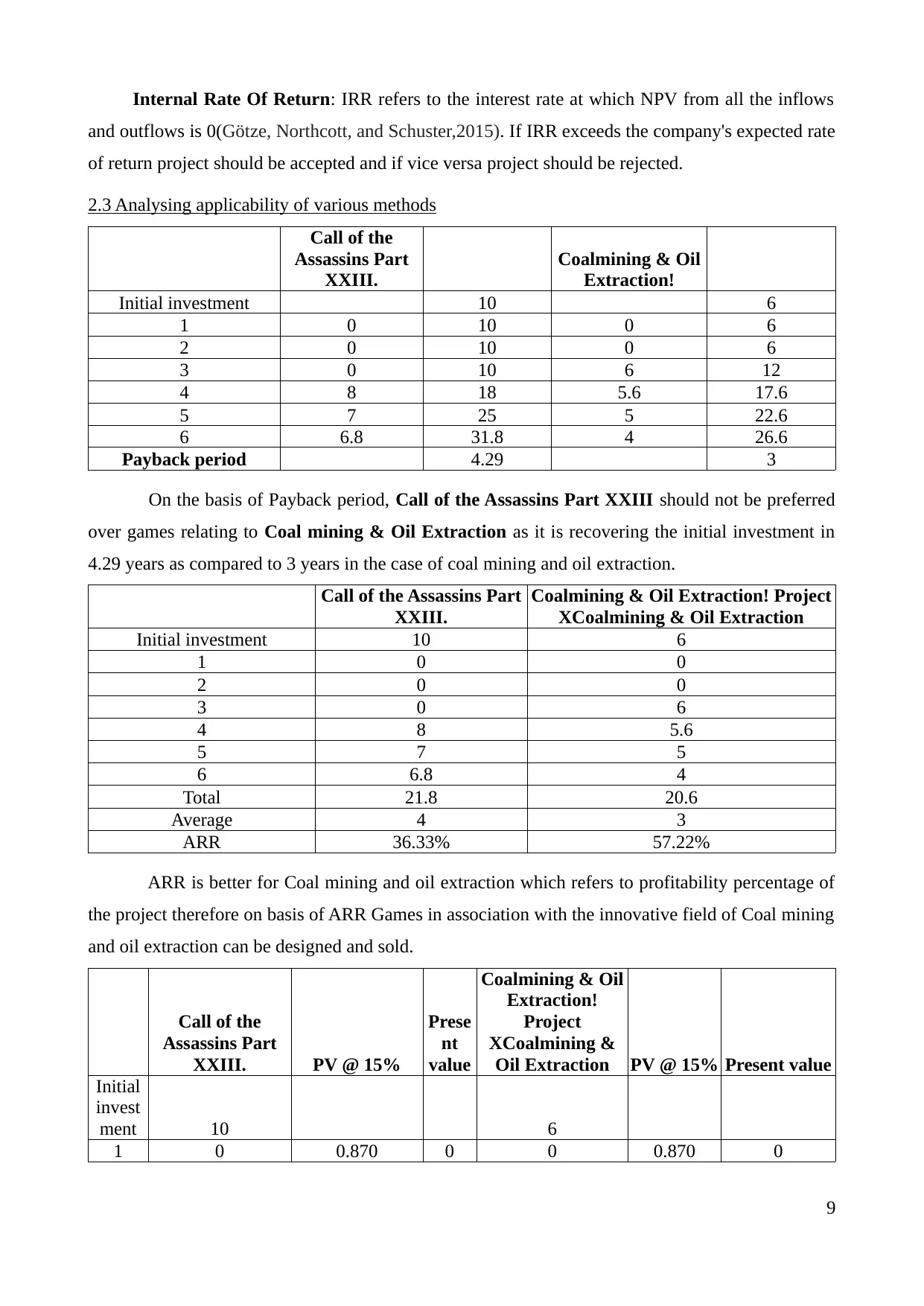
Internal Rate Of Return: IRR refers to the interest rate at which NPV from all the inflows
and outflows is 0(Götze, Northcott, and Schuster,2015). If IRR exceeds the company's expected rate
of return project should be accepted and if vice versa project should be rejected.
2.3 Analysing applicability of various methods
Call of the
Assassins Part
XXIII.
Coalmining & Oil
Extraction!
Initial investment 10 6
1 0 10 0 6
2 0 10 0 6
3 0 10 6 12
4 8 18 5.6 17.6
5 7 25 5 22.6
6 6.8 31.8 4 26.6
Payback period 4.29 3
On the basis of Payback period, Call of the Assassins Part XXIII should not be preferred
over games relating to Coal mining & Oil Extraction as it is recovering the initial investment in
4.29 years as compared to 3 years in the case of coal mining and oil extraction.
Call of the Assassins Part
XXIII.
Coalmining & Oil Extraction! Project
XCoalmining & Oil Extraction
Initial investment 10 6
1 0 0
2 0 0
3 0 6
4 8 5.6
5 7 5
6 6.8 4
Total 21.8 20.6
Average 4 3
ARR 36.33% 57.22%
ARR is better for Coal mining and oil extraction which refers to profitability percentage of
the project therefore on basis of ARR Games in association with the innovative field of Coal mining
and oil extraction can be designed and sold.
Call of the
Assassins Part
XXIII. PV @ 15%
Prese
nt
value
Coalmining & Oil
Extraction!
Project
XCoalmining &
Oil Extraction PV @ 15% Present value
Initial
invest
ment 10 6
1 0 0.870 0 0 0.870 0
9
and outflows is 0(Götze, Northcott, and Schuster,2015). If IRR exceeds the company's expected rate
of return project should be accepted and if vice versa project should be rejected.
2.3 Analysing applicability of various methods
Call of the
Assassins Part
XXIII.
Coalmining & Oil
Extraction!
Initial investment 10 6
1 0 10 0 6
2 0 10 0 6
3 0 10 6 12
4 8 18 5.6 17.6
5 7 25 5 22.6
6 6.8 31.8 4 26.6
Payback period 4.29 3
On the basis of Payback period, Call of the Assassins Part XXIII should not be preferred
over games relating to Coal mining & Oil Extraction as it is recovering the initial investment in
4.29 years as compared to 3 years in the case of coal mining and oil extraction.
Call of the Assassins Part
XXIII.
Coalmining & Oil Extraction! Project
XCoalmining & Oil Extraction
Initial investment 10 6
1 0 0
2 0 0
3 0 6
4 8 5.6
5 7 5
6 6.8 4
Total 21.8 20.6
Average 4 3
ARR 36.33% 57.22%
ARR is better for Coal mining and oil extraction which refers to profitability percentage of
the project therefore on basis of ARR Games in association with the innovative field of Coal mining
and oil extraction can be designed and sold.
Call of the
Assassins Part
XXIII. PV @ 15%
Prese
nt
value
Coalmining & Oil
Extraction!
Project
XCoalmining &
Oil Extraction PV @ 15% Present value
Initial
invest
ment 10 6
1 0 0.870 0 0 0.870 0
9
⊘ This is a preview!⊘
Do you want full access?
Subscribe today to unlock all pages.

Trusted by 1+ million students worldwide
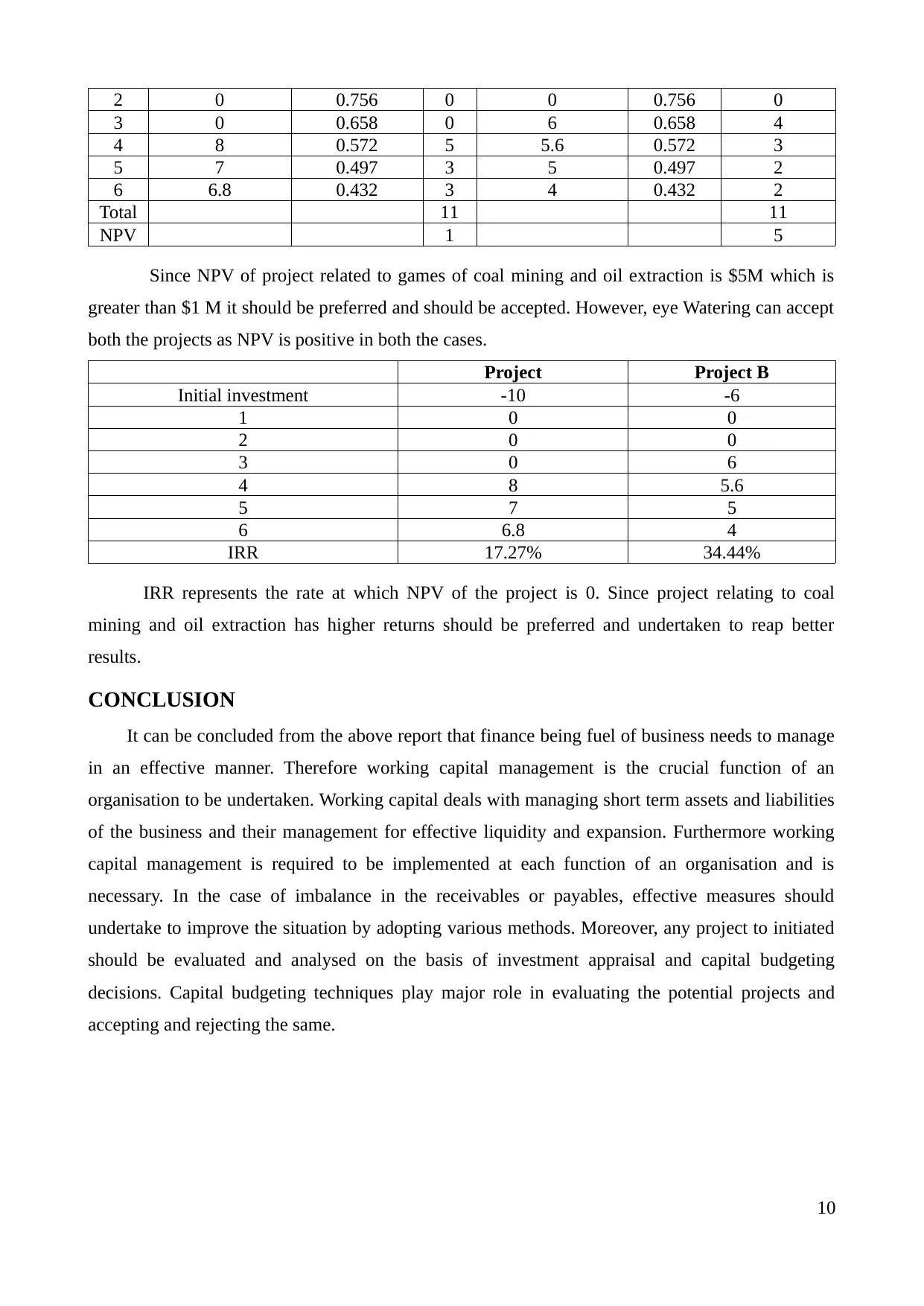
2 0 0.756 0 0 0.756 0
3 0 0.658 0 6 0.658 4
4 8 0.572 5 5.6 0.572 3
5 7 0.497 3 5 0.497 2
6 6.8 0.432 3 4 0.432 2
Total 11 11
NPV 1 5
Since NPV of project related to games of coal mining and oil extraction is $5M which is
greater than $1 M it should be preferred and should be accepted. However, eye Watering can accept
both the projects as NPV is positive in both the cases.
Project Project B
Initial investment -10 -6
1 0 0
2 0 0
3 0 6
4 8 5.6
5 7 5
6 6.8 4
IRR 17.27% 34.44%
IRR represents the rate at which NPV of the project is 0. Since project relating to coal
mining and oil extraction has higher returns should be preferred and undertaken to reap better
results.
CONCLUSION
It can be concluded from the above report that finance being fuel of business needs to manage
in an effective manner. Therefore working capital management is the crucial function of an
organisation to be undertaken. Working capital deals with managing short term assets and liabilities
of the business and their management for effective liquidity and expansion. Furthermore working
capital management is required to be implemented at each function of an organisation and is
necessary. In the case of imbalance in the receivables or payables, effective measures should
undertake to improve the situation by adopting various methods. Moreover, any project to initiated
should be evaluated and analysed on the basis of investment appraisal and capital budgeting
decisions. Capital budgeting techniques play major role in evaluating the potential projects and
accepting and rejecting the same.
10
3 0 0.658 0 6 0.658 4
4 8 0.572 5 5.6 0.572 3
5 7 0.497 3 5 0.497 2
6 6.8 0.432 3 4 0.432 2
Total 11 11
NPV 1 5
Since NPV of project related to games of coal mining and oil extraction is $5M which is
greater than $1 M it should be preferred and should be accepted. However, eye Watering can accept
both the projects as NPV is positive in both the cases.
Project Project B
Initial investment -10 -6
1 0 0
2 0 0
3 0 6
4 8 5.6
5 7 5
6 6.8 4
IRR 17.27% 34.44%
IRR represents the rate at which NPV of the project is 0. Since project relating to coal
mining and oil extraction has higher returns should be preferred and undertaken to reap better
results.
CONCLUSION
It can be concluded from the above report that finance being fuel of business needs to manage
in an effective manner. Therefore working capital management is the crucial function of an
organisation to be undertaken. Working capital deals with managing short term assets and liabilities
of the business and their management for effective liquidity and expansion. Furthermore working
capital management is required to be implemented at each function of an organisation and is
necessary. In the case of imbalance in the receivables or payables, effective measures should
undertake to improve the situation by adopting various methods. Moreover, any project to initiated
should be evaluated and analysed on the basis of investment appraisal and capital budgeting
decisions. Capital budgeting techniques play major role in evaluating the potential projects and
accepting and rejecting the same.
10
Paraphrase This Document
Need a fresh take? Get an instant paraphrase of this document with our AI Paraphraser
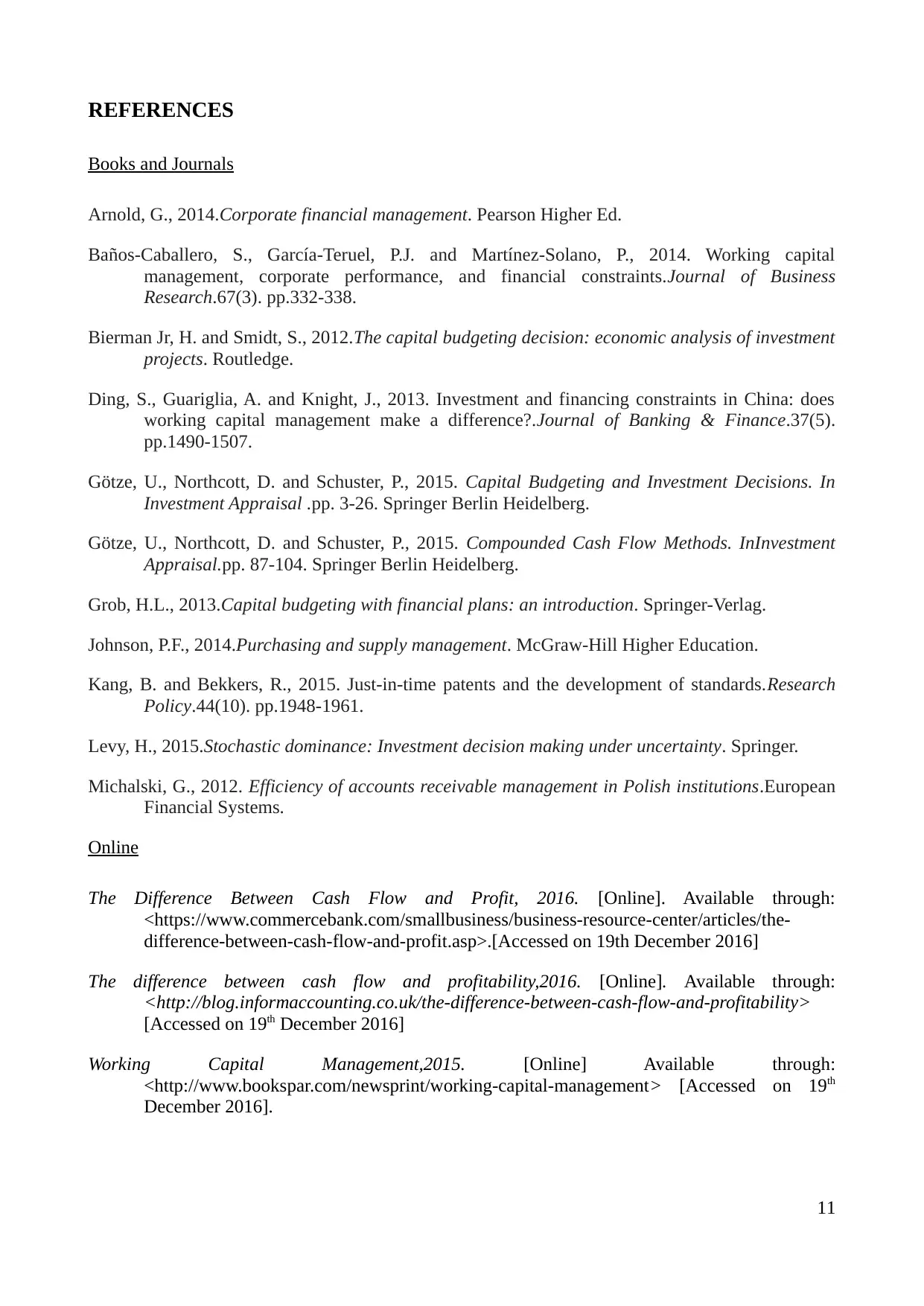
REFERENCES
Books and Journals
Arnold, G., 2014.Corporate financial management. Pearson Higher Ed.
Baños-Caballero, S., García-Teruel, P.J. and Martínez-Solano, P., 2014. Working capital
management, corporate performance, and financial constraints.Journal of Business
Research.67(3). pp.332-338.
Bierman Jr, H. and Smidt, S., 2012.The capital budgeting decision: economic analysis of investment
projects. Routledge.
Ding, S., Guariglia, A. and Knight, J., 2013. Investment and financing constraints in China: does
working capital management make a difference?.Journal of Banking & Finance.37(5).
pp.1490-1507.
Götze, U., Northcott, D. and Schuster, P., 2015. Capital Budgeting and Investment Decisions. In
Investment Appraisal .pp. 3-26. Springer Berlin Heidelberg.
Götze, U., Northcott, D. and Schuster, P., 2015. Compounded Cash Flow Methods. InInvestment
Appraisal.pp. 87-104. Springer Berlin Heidelberg.
Grob, H.L., 2013.Capital budgeting with financial plans: an introduction. Springer-Verlag.
Johnson, P.F., 2014.Purchasing and supply management. McGraw-Hill Higher Education.
Kang, B. and Bekkers, R., 2015. Just-in-time patents and the development of standards.Research
Policy.44(10). pp.1948-1961.
Levy, H., 2015.Stochastic dominance: Investment decision making under uncertainty. Springer.
Michalski, G., 2012. Efficiency of accounts receivable management in Polish institutions.European
Financial Systems.
Online
The Difference Between Cash Flow and Profit, 2016. [Online]. Available through:
<https://www.commercebank.com/smallbusiness/business-resource-center/articles/the-
difference-between-cash-flow-and-profit.asp>.[Accessed on 19th December 2016]
The difference between cash flow and profitability,2016. [Online]. Available through:
<http://blog.informaccounting.co.uk/the-difference-between-cash-flow-and-profitability>
[Accessed on 19th December 2016]
Working Capital Management,2015. [Online] Available through:
<http://www.bookspar.com/newsprint/working-capital-management> [Accessed on 19th
December 2016].
11
Books and Journals
Arnold, G., 2014.Corporate financial management. Pearson Higher Ed.
Baños-Caballero, S., García-Teruel, P.J. and Martínez-Solano, P., 2014. Working capital
management, corporate performance, and financial constraints.Journal of Business
Research.67(3). pp.332-338.
Bierman Jr, H. and Smidt, S., 2012.The capital budgeting decision: economic analysis of investment
projects. Routledge.
Ding, S., Guariglia, A. and Knight, J., 2013. Investment and financing constraints in China: does
working capital management make a difference?.Journal of Banking & Finance.37(5).
pp.1490-1507.
Götze, U., Northcott, D. and Schuster, P., 2015. Capital Budgeting and Investment Decisions. In
Investment Appraisal .pp. 3-26. Springer Berlin Heidelberg.
Götze, U., Northcott, D. and Schuster, P., 2015. Compounded Cash Flow Methods. InInvestment
Appraisal.pp. 87-104. Springer Berlin Heidelberg.
Grob, H.L., 2013.Capital budgeting with financial plans: an introduction. Springer-Verlag.
Johnson, P.F., 2014.Purchasing and supply management. McGraw-Hill Higher Education.
Kang, B. and Bekkers, R., 2015. Just-in-time patents and the development of standards.Research
Policy.44(10). pp.1948-1961.
Levy, H., 2015.Stochastic dominance: Investment decision making under uncertainty. Springer.
Michalski, G., 2012. Efficiency of accounts receivable management in Polish institutions.European
Financial Systems.
Online
The Difference Between Cash Flow and Profit, 2016. [Online]. Available through:
<https://www.commercebank.com/smallbusiness/business-resource-center/articles/the-
difference-between-cash-flow-and-profit.asp>.[Accessed on 19th December 2016]
The difference between cash flow and profitability,2016. [Online]. Available through:
<http://blog.informaccounting.co.uk/the-difference-between-cash-flow-and-profitability>
[Accessed on 19th December 2016]
Working Capital Management,2015. [Online] Available through:
<http://www.bookspar.com/newsprint/working-capital-management> [Accessed on 19th
December 2016].
11
1 out of 11
Related Documents
Your All-in-One AI-Powered Toolkit for Academic Success.
+13062052269
info@desklib.com
Available 24*7 on WhatsApp / Email
![[object Object]](/_next/static/media/star-bottom.7253800d.svg)
Unlock your academic potential
Copyright © 2020–2025 A2Z Services. All Rights Reserved. Developed and managed by ZUCOL.





